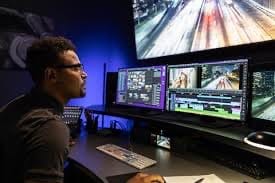Column, DNEWSINFO– In today’s fast-paced media landscape, speed and accuracy are paramount. To meet these demands, many TV and radio stations are increasingly turning to Artificial Intelligence (AI) to assist with editing and managing live broadcasts
From generating real-time captions to producing instant replays, AI is revolutionizing broadcast production by making it quicker, more efficient, and more accessible.
One of the most impactful applications of AI in live broadcasting is the rapid creation of subtitles and translations. AI-powered speech recognition technology can convert spoken words into text instantly during live programs. This advancement not only improves accessibility for viewers with hearing impairments but also facilitates translation for international audiences, broadening the reach and inclusivity of broadcasts. The ability to provide accurate, real-time captions enhances viewer engagement and ensures that content is comprehensible across language barriers.
AI also excels at generating instant highlight clips, particularly valuable in sports and breaking news coverage. By detecting significant moments—such as goals, crowd reactions, or critical events—AI can automatically create short video clips that are ready for immediate broadcast or social media sharing. This automation eliminates the need for lengthy manual editing, allowing broadcasters to deliver timely highlights that keep audiences informed and entertained in real time.
Beyond editing, AI enhances the technical quality of live broadcasts. Smart camera systems powered by AI can autonomously track and focus on key subjects, dynamically switching angles to capture the most compelling shots during live events. This capability reduces the need for manual camera operation and ensures seamless coverage. Additionally, AI improves audio quality by filtering out background noise, which is particularly beneficial for reporters working in challenging outdoor environments, delivering clearer sound to viewers and listeners.
AI also plays a critical role in maintaining content safety during live broadcasts. It can detect and mute inappropriate language or blur sensitive visuals in real time, helping broadcasters comply with regulatory standards and protect audience sensibilities. Furthermore, AI can quickly add live graphics such as name tags, news tickers, and scoreboards with precision and speed, enhancing the viewer experience without interrupting the flow of the broadcast.
Despite these advances, AI is not poised to replace human creativity and judgment. While AI efficiently handles routine and fast-paced tasks, human editors and journalists remain essential for crafting compelling narratives, verifying facts, and making editorial decisions that require nuance and ethical consideration. The collaboration between AI and human professionals ensures that broadcasts are not only technically polished but also meaningful and trustworthy.
In conclusion, AI is transforming live broadcast editing by making the process faster, smarter, and more reliable. For media students and aspiring broadcasters, gaining proficiency with AI tools is becoming an indispensable part of preparing for the future of the industry. Embracing AI’s capabilities while valuing human creativity will be key to producing engaging, high-quality live content in the evolving media landscape.
Edited and Compiled by Miracle Ene Ameh | July 10, 2025.
Discover more from DnewsInfo
Subscribe to get the latest posts sent to your email.





